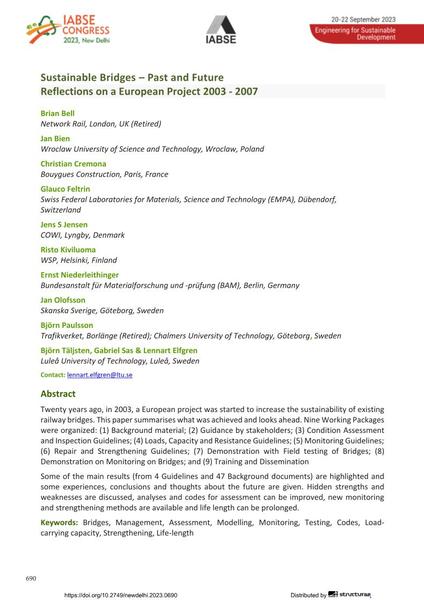Sustainable Bridges – Past and Future: Reflections on a European Project 2003 - 2007

|
|
|||||||||||
Bibliographic Details
| Author(s): |
Brian Bell
(Network Rail, London, UK (Retired))
Jan Bień (Wroclaw University of Science and Technology, Wroclaw, Poland) Christian Crémona (Bouygues Construction, Paris, France) Glauco Feltrin (Swiss Federal Laboratories for Materials, Science and Technology (EMPA), Döbendorf, Switzerland) Jens S. Jensen (COWi, Lyngby, Denmark) Risto Kiviluoma (WSP, Helsinki, Finland) Ernst Niederleithinger (Bundesanstalt fOr Materialforschung und -prOfung (BAM), Berlin, Germany) Jan Olofsson (Skanska Sverige, Goteborg, Sweden) Björn Paulsson (Trafikverket, Borli:inge (Retired); Chalmers University of Technology, Goteborg, Sweden) Björn Täljsten (Lulea University of Technology, Lulea, Sweden) Gabriel Sas (Lulea University of Technology, Lulea, Sweden) Lennart Elfgren (Lulea University of Technology, Lulea, Sweden) |
||||
|---|---|---|---|---|---|
| Medium: | conference paper | ||||
| Language(s): | English | ||||
| Conference: | IABSE Congress: Engineering for Sustainable Development, New Delhi, India, 20-22 September 2023 | ||||
| Published in: | IABSE Congress New Delhi 2023 | ||||
|
|||||
| Page(s): | 690-698 | ||||
| Total no. of pages: | 9 | ||||
| DOI: | 10.2749/newdelhi.2023.0690 | ||||
| Abstract: |
Twenty years ago, in 2003, a European project was started to increase the sustainability of existing railway bridges. This paper summarises what was achieved and looks ahead. Nine Working Packages were organized: (1) Background material; (2) Guidance by stakeholders; (3) Condition Assessment and Inspection Guidelines; (4) Loads, Capacity and Resistance Guidelines; (5) Monitoring Guidelines; (6) Repair and Strengthening Guidelines; (7) Demonstration with Field testing of Bridges; (8) Demonstration on Monitoring on Bridges; and (9) Training and Dissemination Some of the main results (from 4 Guidelines and 47 Background documents) are highlighted and some experiences, conclusions and thoughts about the future are given. Hidden strengths and weaknesses are discussed, analyses and codes for assessment can be improved, new monitoring and strengthening methods are available and life length can be prolonged. |
||||
| Keywords: |
bridges modelling management testing strengthening codes assessment monitoring load- carrying capacity Life-length
|
||||
